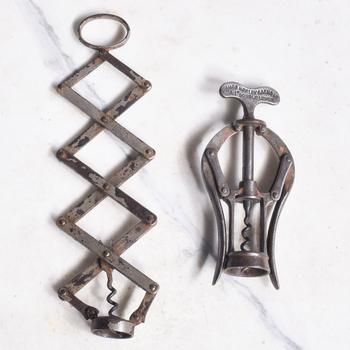featured item
Collecting with Iain: why antique corkscrews should be collector's items
Posted by Chris on 12/01/2024
Do you know how bottles of wine are bought around the world in 1 year?
31.4 billion bottles!
Whilst a lot of these will come with screw tops, can you imagine how many corks there are that need to be removed?
The problem has always been this: how do we open them?
Even the Romans couldn’t work that one out. But nowadays, our little friend – stuck in the back of the kitchen drawer – has seen a lot of wine in its time.
In this article, Antiques.co.uk founder Iain Brunt explores the history and development of the trusty corkscrew - and why they should be collector's items.
Jump to section:
Pictured: Edwardian Metal Table Cork Screw, c.1900
How corkscrews started: designs and patents
The earliest reference to a corkscrew was noted in 1680, when they were delightfully called ‘steel worms’. Interestingly, they had actually originated from a gun cleaning instrument. Over the next 324 years various designs were created and patented.
The first corkscrew patent was registered by Hensall and Bouton in 1795, who had designed a disc preventing the user screwing too deeply into the bottle, and breaking the glass bottle neck. This mechanism was used for over 100 years.
In 1882 Carl F A Wienke, a German inventor, patented the ‘Waiter’s Friend’. This design featured a knife shaped appearance, and later became known as the ‘Sommelier’s knife’.
H S Heeley in 1888 developed the double wing corkscrew, whereby two wings rose on each side as it screwed, enabling the cork to removed safely. This method was then patented in the USA by Donik Rosati and the design still remains very popular. It’s likely to be this design that many of us have in that kitchen drawer.
Pictured: Jules Mumm Antique Decorative Corkscrew, c.1920 (Waiter's Friend)
Corkscrews as collector’s items
So in terms of antiques, why isn’t this fabulous item more of a collector’s item? Peter Borrett has a great collection in the UK, and you'll find some listed with Antiques.co.uk under 'cork' and 'corkscrew'.
What is fascinating about these household appliances is that they are so ubiquitous – I don’t know a house without one. But a big question in the antiques world is, ‘who has the rarest and the earliest one?’… and, ‘when did we start putting corks into our bottles?’
The use of cork
Cork has been around from as early as the fourth century when the Egyptians used them as floats.
But it wasn’t until the 17th century that cork became widely used…and it’s been in use in virtually every bottle since.
Early bottles were hand blown and size was mostly determined by the blowers individual lung capacity – not great if your local glassblower was a committed pipe smoker!
At this time, corks were stuck in the top of the bottle and left sticking out – primarily because corkscrews had not yet been invented, so it was the only way of taking one out. In the 17th century, inexpensive bottles appeared in France and in 1703 a treaty between England and Portugal gave a major boost to cork production.
18th century innovation in bottle design
Skipping ahead to the 18th century, and bottle design changed again. Original glass bottles had been pear-shaped, making them difficult to store. With this change in shape came the fact that corks could now be kept moist during storage.
By the end of 18th century the bottle, cork and corkscrew had brought about a new age in wine history.
For the first time since the Romans, it was possible to enjoy aged wine. So it’s no surprise that Hugh Johnson calls the cork, 'the most important event in the history of fine wine'!
For a very small investment you can start collecting corkscrews on Antiques.co.uk from just £50-00. They make an ideal collector’s item for beginners who love wine and collecting practical antiques.
See all corkscrews listed on Antiques.co.uk.
Some of our favourite antique and vintage corkscrews:
Antique Decorative Champagne Corkscrew
This is an antique decorative champagne corkscrew. A German, white metal and brass multi tool with Jules Mumm branding, dating to the early 20th century, circa 1920. Fascinating example of publicity merchandise for the French champagne maker.
Price: £495 / $631 | view this item
Unique Corkscrew with its Original Box
The smallest in anyone's collection, told it was used by Georgian Ladies to remove the corks from their small scent bottle container, comes in its original box sizes of which are length 8 cm width 4 cm height 2 cm.
Price: £295 / $376 | view this item
Vintage Walter Bosse Dog Corkscrew Figurine

This is a wonderfully quirky piece. It is a dog figurine with a corkscrew tail. Created by Walter Bosse, in hand crafted brass, it measures 11cm from nose to tail.
Created between the 1920s and 1960s, Bosse’s unique figurines are as intriguing today as they were decades ago, and serve as a source of happiness and inspiration to collectors around the world.
Price: £PLEASE ENQUIRE | view this item
Hans Hansen Rosewood With Silver Corkscrew

Price: £122 / $156 | view this item









